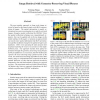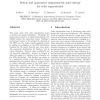197
Voted
COSIT
2011
Springer
14 years 10 days ago
2011
Springer
If spatial cognition hopes to understand memory of and reasoning about real-world environments, then all aspects of the environment, both spatial and non-spatial need to be conside...
118
Voted
CVPR
2011
IEEE
14 years 7 months ago
2011
IEEE
The most popular approach to large scale image retrieval is based on the bag-of-visual-word (BoV) representation of images. The spatial information is usually reintroduced as a po...
109
Voted
GIS
2010
ACM
14 years 10 months ago
2010
ACM
ended abstract looks forward at which shared concepts and approaches are shaping future research in the field of location privacy, as well as reflecting on the broader achievement...
137
Voted
IJCV
2008
14 years 11 months ago
2008
This paper deals with video segmentation based on motion and spatial information. Classically, the motion term is based on a motion compensation error (MCE) between two consecutiv...
118
Voted
RAS
2008
15 years 16 hour ago
2008
Task planning for mobile robots usually relies solely on spatial information and on shallow domain knowledge, like labels attached to objects and places. Although spatial informat...
136
Voted
AGIS
1998
15 years 7 days ago
1998
With the development of modern cities, 3-D spatial information systems (SIS) are increasingly required for spatial planning, communication systems and other applications. The geom...
115
Voted
IJAR
2008
15 years 17 days ago
2008
Qualitative spatial information plays a key role in many applications. While it is well-recognized that all but a few of these applications deal with spatial information that is a...
108
Voted
SPATIALCOGNITION
2000
Springer
15 years 4 months ago
2000
Springer
The transfer of spatial knowledge from virtual to real environments is one important issue in spatial cognition research. Up to now, studies in this domain have revealed that the p...
120
Voted
SPATIALCOGNITION
2000
Springer
15 years 4 months ago
2000
Springer
An approach to high-level interaction with autonomous robots by means of schematic maps is outlined. Schematic maps are knowledge representation structures to encode qualitative s...
112
Voted
SPATIALCOGNITION
2000
Springer
15 years 4 months ago
2000
Springer
Memory representations of spatial information require the choice of one or more reference systems to specify spatial relations. In two experiments we investigated the role of diffe...







